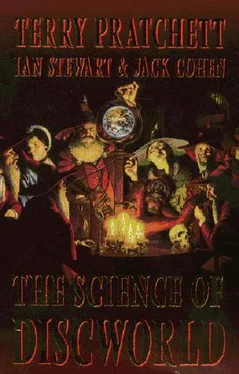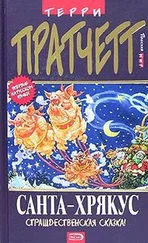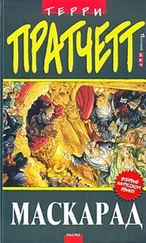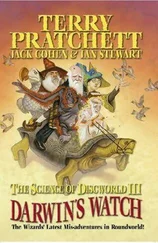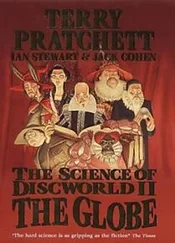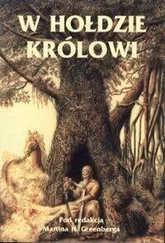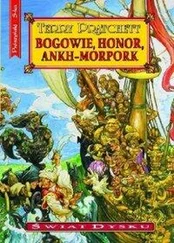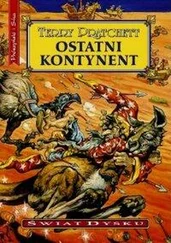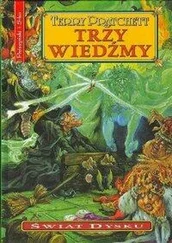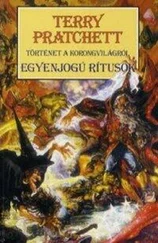Terry Pratchett - Science of Discworld
Здесь есть возможность читать онлайн «Terry Pratchett - Science of Discworld» весь текст электронной книги совершенно бесплатно (целиком полную версию без сокращений). В некоторых случаях можно слушать аудио, скачать через торрент в формате fb2 и присутствует краткое содержание. Жанр: Фантастика и фэнтези, на английском языке. Описание произведения, (предисловие) а так же отзывы посетителей доступны на портале библиотеки ЛибКат.
- Название:Science of Discworld
- Автор:
- Жанр:
- Год:неизвестен
- ISBN:нет данных
- Рейтинг книги:4 / 5. Голосов: 1
-
Избранное:Добавить в избранное
- Отзывы:
-
Ваша оценка:
- 80
- 1
- 2
- 3
- 4
- 5
Science of Discworld: краткое содержание, описание и аннотация
Предлагаем к чтению аннотацию, описание, краткое содержание или предисловие (зависит от того, что написал сам автор книги «Science of Discworld»). Если вы не нашли необходимую информацию о книге — напишите в комментариях, мы постараемся отыскать её.
Science of Discworld — читать онлайн бесплатно полную книгу (весь текст) целиком
Ниже представлен текст книги, разбитый по страницам. Система сохранения места последней прочитанной страницы, позволяет с удобством читать онлайн бесплатно книгу «Science of Discworld», без необходимости каждый раз заново искать на чём Вы остановились. Поставьте закладку, и сможете в любой момент перейти на страницу, на которой закончили чтение.
Интервал:
Закладка:
What kind of drama? An important clue comes from deposits of iridium, a rare metal in the Earth's crust. Iridium is distinctly more common in some meteorites, particularly those from the asteroid belt between Mars and Jupiter So if you find an unusually rich deposit of iridium on Earth, then it may well have come from an impacting meteorite.
In 1979 the Nobel-winning physicist Luis Alvarez was musing along such lines, and he and his geologist son Walter Alvarez discovered a layer of clay that contains a hundred times as much iridium as normal. It was laid down right at the K/T boundary, and it can be found over the whole of the Earth's land mass. The Alvarezes interpreted this discovery as a strong hint that a meteorite impact caused the K/T extinction. The total amount of iridium in the layer is estimated to be around 200,000 tons (tonnes), which is about the amount you'd expect to find in a meteorite 6 miles (10 km) across. If a meteorite that size were to hit the Earth, travelling at a typical 10 miles per second (16 kps), it would leave an impact crater 40 miles (65 km) in diameter. The blast would have been equivalent to thousands of hydrogen bombs, it would have thrown enormous quantities of dust into the atmosphere, blanking out sunlight for years, and if it happened to hit the ocean, a better than 50/50 chance, it would cause huge tidal waves and a short-lived burst of superheated steam. Plants would die, large plant-eating dinosaurs would run out of food and die too, carnivorous dinosaurs would quickly follow. Insects would on the whole fare a little better, as would insect-eaters.
Much evidence has accumulated that the Chicxulub crater, a buried rock formation in the Yucatan region of southern Mexico, is the remnant of this impact. Crystals of Shocked' quartz were spread far and wide from the impact site: the biggest ones are found near the crater, and smaller ones are found half way round the world. In 1998 a piece of the actual meteorite, a tenth of an inch (2.5 mm) across, was found in the north Pacific Ocean by Frank Kyte. The fragment looks like part of an asteroid, ruling out a possible alternative, a comet, which might also create a similar crater. According to A. Shukolyukov and G.W. Lugmair, the proportions of chromium isotopes in K/T sediment confirm that view. And Andrew Smith and Charlotte Jeffery have found that mass die-backs of sea urchins which occurred at the K/T boundary were worst in the regions around central America, where we think the meteorite came down.
Although the evidence for an impact is strong, and has grown considerably over the twenty years since the Alvarezes first advanced their meteorite-strike theory, a strongly dissenting group of palaeontologists has looked to terrestrial events, not dramatic astronomical interference, to explain the K/T extinction. There was certainly a rapid series of climatic changes at the end of the Cretaceous, with very drastic changes of sea level as ice caps grew or melted. There is also good evidence that some seas, perhaps all, lost their oxygen-based ecology to become vast, stinking, black, anaerobic sinks. The fossil evidence for this consists of black iron-and sulphur-rich lines in sediments. The most dramatic terrestrial events were undoubtedly associated with the vulcanism which resulted in the so-called Deccan Traps, huge geological deposits of lava. The whole of Asia seems to have been covered with volcanoes, and they produced enough lava that it would have formed a layer 50 yards (45 m) thick if it had been spread over the whole continent. Such extensive vulcanism would have had enormous effects on the atmosphere; carbon dioxide emissions that warmed the atmosphere by the greenhouse effect, sulphur compounds resulting in terrible acid rain and freshwater pollution over the entire planet, and tiny rock particles blocking sunlight and causing 'nuclear winters' for decades at a time. Could the volcanoes that formed the Deccan Traps have killed the dinosaurs, instead of a meteorite? Much depends on the timing.
Our preferred theory, not because there is good independent evidence for it but because it would explain so much, and because it has a moral, is that the two causes are linked. The Chicxulub crater is very nearly opposite the Deccan Traps, on the other side of the planet. Perhaps volcanic activity in Asia began some millions of years before the K/T boundary, causing occasional ecological crises for the larger animals but nothing really final Then the meteorite hit, causing shockwaves which passed right through the Earth and converged, focused as if by a lens on just that fragile region of the planet's crust. (A similar effect happened on Mercury, where a gigantic impact crater called the Caloris Basin is directly opposite 'weird terrain' caused by focused shockwaves.)
There would then have been a gigantic, synchronized burst of vulcanism, on top of all the events of the collision, which would have been pretty bad on their own. The combination could have polished off innumerable animal species. In support of this idea, it should be said that another geological deposit, the Siberian Traps, contains ten times as much lava as the Deccan system, and it so happens that the Siberian Traps were kid down at the time of another mass extinction, the great Permian extinction, which we mentioned earlier. To pile on further evidence: some geologists believe they have found another meteorite impact site in modern Australia, which in Permian times was opposite to Siberia.
The moral of this tale is that we should not look for 'the' cause of the dinosaur extinction. It is very rare for there to be just one cause of a natural event, unlike scientific experiments which are specially set up to reveal unique explanations.
On Discworld, not only does Death come for humans, scythe in hand, but diminutive sub-Deaths come for other animals, for example the Death of Rats in Soul Music , from whom a single, typical quote will suffice: 'SQUEAK.'
The Death of Dinosaurs would have been something to see, with volcanoes in one hand and an asteroid in the other, trailing a cloak of ice ...
They were wonderfully cinematic reptiles, weren't they? Trust the wizards to get it wrong.
There is another lesson to be learned from our emphasis on the demise of the dinosaurs. Many other large and/or dramatic reptiles died out at the end of the Cretaceous, notably the plesiosaurs (famous as a possible 'explanation' of the mythical Loch Ness monster), the ichthyosaurs (enormous fish-shaped predators, reptilian whales and dolphins), the pterosaurs (strange flying forms, of which the pterodactyls appear in all the dinosaur films and are labelled, wrongly, dinosaurs), and especially the mosasaurs .,.
Mosasaurs?
What were they? They were as dramatic as the dinosaurs, but they weren't dinosaurs. They didn't have as good a PR firm, though, because few non-specialists have heard of them. They are popularly known as fish-lizards, not as good a name as 'terrible lizard', and it describes them well. Some were nearly as fish-like as ichthyosaurs, or dolphins, some were rather crocodile-like, some were fifty-foot predators like the great white shark, some were just a couple of feet long and fed on baby ammonites and other common molluscs. They lasted a good twenty million years, and for much of that time they seem to have been the dominant marine predators. Yet most people meet the word in stories about dinosaurs, assume that the mosasaur was a not-very-interesting kind of dinosaur, and promptly forget them.
The other really strange thing about the K/T extinction, probably not a 'thing' in any meaningful sense, because in this context a thing would be an equation of unknowns, whereas what we have is a diversity of related puzzles, is which creatures survived it. In the sea, the ammonites all died out, as did the other shelled forms like belemnites, unrolled ammonites, but the nautilus came through, as did the cuttlefish, squids, and octopuses. Amazingly the crocodiles, which to our eyes are about as dinosaur-like as you can get without actually being one, survived the K/T event with little loss of diversity. And those little dinosaurs called 'birds' came through pretty well unscathed. (There's a story here that we need to tell, quickly. Not so long ago, the idea that birds are the living remnants of the dinosaurs was new, controversial, and therefore a hot topic. Then it rapidly turned into the prevailing wisdom. New fossil discoveries, however, have shown conclusively that the major families of modern birds diverged, in an evolutionary sense, long before the K/T event. So they aren't remnants of the dinosaurs that otherwise died, they got out early by ceasing to be dinosaurs at all.)
Читать дальшеИнтервал:
Закладка:
Похожие книги на «Science of Discworld»
Представляем Вашему вниманию похожие книги на «Science of Discworld» списком для выбора. Мы отобрали схожую по названию и смыслу литературу в надежде предоставить читателям больше вариантов отыскать новые, интересные, ещё непрочитанные произведения.
Обсуждение, отзывы о книге «Science of Discworld» и просто собственные мнения читателей. Оставьте ваши комментарии, напишите, что Вы думаете о произведении, его смысле или главных героях. Укажите что конкретно понравилось, а что нет, и почему Вы так считаете.
